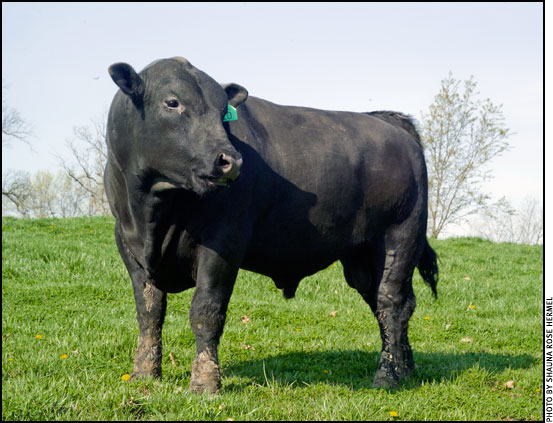
Sally Northcutt
Association Perspective
Association continues to enhance genetic
prediction tools.
The American Angus Association and Angus Genetics Inc. (AGI) continue to enhance the suite of genetic prediction tools offered to Angus producers and customers of Angus genetics. Three notable recent enhancements include:
• Expected progeny differences (EPDs) calculated on weekly basis have been expanded to include all traits except for the heifer pregnancy research prediction.
• A genomic component based on the Igenity Profile for Angus has been included in growth trait predictions, providing genomic-enhanced EPDs for those traits to complement those already calculated for carcass traits, docility and residual average daily gain (RADG).
• A genomic component based on the Pfizer HD50K for Angus has been included in the carcass and RADG EPDs, producing the first genomic-enhanced EPDs affected by DNA test results of two companies (Igenity and Pfizer).
For commercial customers, the benefit is higher-accuracy EPDs on yearling bulls. Read more.
After the Storm
Effects of winter storms will take time to work through cattle markets.
Virtually all sectors of cattle and beef markets have been affected by two major winter storms that hit a week apart in February, leading producers to scramble to care for animals and maintain production.
"Significant snowfall and record low temperatures, especially with the wind chills, have disrupted markets and pushed both cattle and cattle managers well out of their normal operating ranges," said Derrell Peel, Oklahoma State University Cooperative Extension livestock marketing specialist. Read more.
Long-Range Plan Discussed
at Policy Division Forum
During an early session of the 2011 Cattle Industry Convention in Denver, attendees were presented with a summary of a proposed Long-Range Plan for guiding the U.S. beef industry during the next three years. Later, during the convention's Policy Division Forum, they learned the details from Barry Carpenter of the National Meat Association and Homer Buell, a Nebraska cow-calf producer. Both men were among the 23 members of a task force representing multiple beef industry organizations, which drafted the plan.
According to Carpenter and Buell, the Long-Range Plan pursues a stated mission: "To provide the safest, highest-quality, most consumer-friendly beef and beef products in an environmentally and economically sustainable manner." In tag-team fashion, the pair explained the plan's core strategies and goals for accomplishing that mission. Read more.
What’s Inside …
In this February edition of the Angus Beef Bulletin EXTRA, you'll find valuable articles devoted to the management, marketing, and health and nutrition of your beef enterprise. Select from the tabs at the top of the page to access this month's entire offering by category. A few select features include:
• Increasing Corn Stover Digestibility
• Financing in the Age of Uncertainty
• Water Is the Most Important Nutrient
• Expect More Attempts to Limit Antimocrobial Use
• Some Tricks to Get a Calf to Breathe
• Low Heifer Retention and Tight Feeder-Cattle Supplies
• Live Cattle Marketing Committee Discussess Eastern Bankruptcy
• American Heart Association Puts Its Mark on Beef
News Briefs …
The American Angus Association and its subsidiaries generate a wealth of information to keep members and affiliates informed of what's happening within the industry as well as with the programs and services they offer. Click here for easy access to the newsrooms of the American Angus Association and Certified Angus Beef LLC and the Angus e-List archive.
NASS Releases Farm Labor Report
Hired workers up 1%, wage rates up 2% from a year ago
There were 807,000 hired workers on the Nation's farms and ranches during the week of Jan. 9-15, 2011, up 1% from a year ago. Of these hired workers, 602,000 were hired directly by farm operators. Agricultural service employees on farms and ranches made up the remaining 205,000 workers.
Farm operators paid their hired workers an average wage of $11.29 per hour during the January 2011 reference week, up 21¢ from a year earlier. Field workers received an average of $10.23 per hour, up 13¢ from last January, while livestock workers earned $10.52 per hour compared with $10.31 a year earlier. The field and livestock worker combined wage rate, at $10.35 per hour, was up 17¢ from last year. The number of hours worked averaged 38.9 for hired workers during the survey week, up 5% from a year ago. Read more.
New Dietary Guidelines
USDA and HHS announce new dietary guidelines to help Americans make healthier food choices and confront the obesity epidemic.
Agriculture Secretary Tom Vilsack and Secretary of the Department of Health and Human Services (HHS) Kathleen Sebelius Jan. 31 announced the release of the 2010 Dietary Guidelines for Americans, the federal government's evidence-based nutritional guidance to promote health, reduce the risk of chronic diseases, and reduce the prevalence of overweight and obesity through improved nutrition and physical activity.
Because more than one-third of children and more than two-thirds of adults in the United States are overweight or obese, the 7th edition of Dietary Guidelines for Americans places stronger emphasis on reducing calorie consumption and increasing physical activity. Read more.
[Click here to go to the top of the page.]








